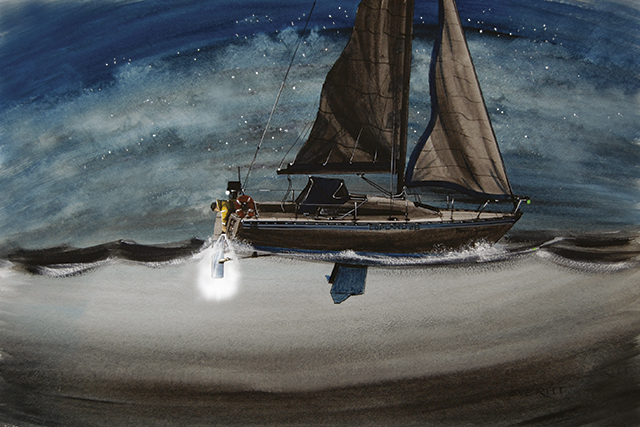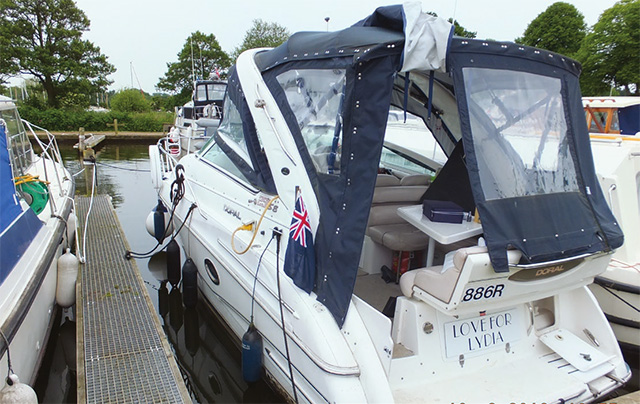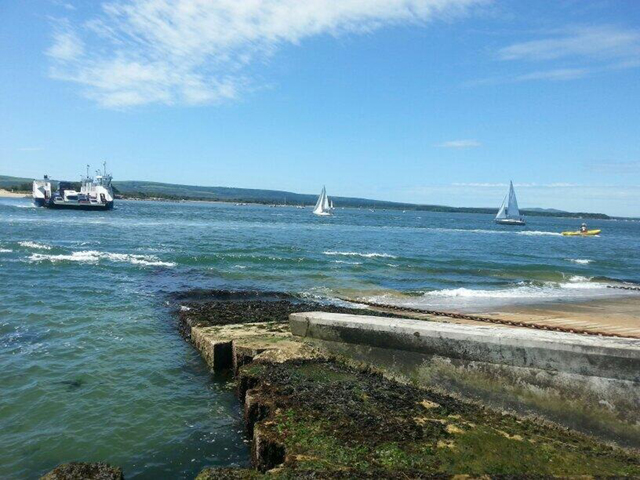"Familiarity breeds contempt and contempt is your enemy with all things to do with the sea" - lessons learned from three recreational boating accidents, and more, in the latest MAIB Safety Digest
A skipper’s hurried trip to the heads contributes to a collision with a ship and the death of his wife; a sports coach in an open launch is lost overboard; and a dangerous combination of electric motors, engines and petrol fumes causes an explosion.
Three hard-hitting reports on recreational boating accidents feature in the latest MAIB Safety Digest 1/2017, published today.

Author of the Recreational Craft section, Steve Usher, warns that: ‘Familiarity breeds contempt and contempt is your enemy with all things to do with the sea. The reports in this issue highlight that all too clearly.
‘A skipper’s hurried trip to the heads contributes to a collision with a ship and the death of his wife. Off guard while on holiday, he set his autopilot after checking on nearby shipping. But one ship altered course without warning while the yacht skipper was returning from below and the collision occurred.
‘In our second story, a sports coach in an open launch – rushing to catch up with his team – tumbles overboard. He has no life jacket and he is not attached to the open launch’s kill cord. It takes more than a month to find his body.
‘And story number three highlights just how dangerous a combination of electric motors, engines and petrol fumes can become in the confined spaces of a boat.
‘You want to be able to relax while boating; it is after all a ‘leisure’ activity for many of us. Yet the dangers of relaxing too much are obvious.
‘Marine accidents are all too often the result of carelessness amongst those involved. Safety MUST factor into all your preparation as well as your actual boating, whether your voyage is about fishing, leisure, sport or just messing about on the river.’
Never, Ever Assume

Damage to starboard side of yacht
It was a clear summer’s day. A 9.5m sailing yacht departed its marina with its owner, his wife and the two family dogs on board with the intention of enjoying a leisurely day sail. The boat was in good condition and well equipped for cruising. The owner was an experienced yachtsman and had sailed extensively both in the local area and further afield.
Both the skipper and his wife wore lifejackets and their dogs wore buoyancy aids. The yacht was initially motored out of the marina, the sails were set and the engine stopped once clear of a busy harbour. The breeze was light and the yacht was sailing at around 4kts. The sea was calm and visibility was excellent. The skipper maintained a course to keep his yacht to the south of a busy shipping channel.
After enjoying lunch in the cockpit, and in order to utilise favourable tidal conditions for the trip back to the marina the skipper decided to turn around, and he began to steer a course to take the yacht back to pick up the recommended yacht route into the harbour. The yacht was approximately 7 miles offshore.
His wife was relaxing, lying on the starboard cockpit bench facing aft, leaning against the cabin bulkhead. A ship had recently sailed from the port and the yacht’s skipper watched this ship to his north proceed out of the harbour following the main shipping channel.
He could see another ship a few miles further away, also proceeding out of the port in the main shipping channel. At approximately 1326 the skipper engaged the yacht’s autopilot; he could see the ship outbound from the port was still in the main channel and by looking at its aspect was content that there was no risk of collision.
Leaving his wife relaxing in the cockpit he went below to visit the heads.

The dredger
At about the same time, the outbound ship made a series of small alterations of course to leave the main channel. This was the ship’s normal route and it followed the same track several times a day. This alteration of course put the ship on a collision course with the yacht. The yacht’s radar echo was clearly visible on the ship’s radar, yet the target had not been acquired and the officer of the watch – who was alone on the bridge of the ship – had not visually sighted the yacht.
The yacht’s skipper was making his way up the companionway steps when he saw the bow of a large vessel through the spray-hood. He shouted a warning to his wife and tried to make a lunge for the tiller. His actions were in vain and the two vessels collided.
The force of the impact threw the skipper back down the companionway steps. Damage to the yacht was catastrophic and it sank within minutes of the collision. The yacht’s skipper managed to escape from within the sinking yacht and was rescued from the water by the ship’s rescue boat. One of the dogs was also rescued. The skipper’s wife could not be found despite an extensive air and sea search. Her body was recovered from the sunken yacht by divers the next day.
The Lessons
1) The yacht’s skipper made an assumption that the outbound ship would remain in the channel and follow the ship that was ahead of it in the channel. When the decision was taken to go below, no risk of collision existed. Subsequent alterations of course by the ship resulted in both vessels being on a collision course.
2) It is essential that all vessels maintain a proper lookout at all times. Motor does give way to sail in most cases, nonetheless all vessels have a duty and requirement to keep a good lookout by all available means and to take avoiding action when it becomes apparent that the actions of the give way vessel alone are not going to be sufficient to avoid the risk of collision.
3) Leisure boat users should never assume that they have been seen by other vessels, nor should they assume that the other vessels will always take the correct avoiding action. In this case the yacht had a good quality radar reflector fitted high on its mast, and this provided a good radar echo. Yet due to the good visibility, the officer on watch on the ship was not using his radar and had not seen the target of the yacht that had been visible on his radar display screen for 12 minutes before the collision.
4) Leisure sailors need to be particularly aware of closing speeds between their own vessels and other vessels. In this case the ship was travelling at 12.9kts, but many types of vessels, including ferries, cruise ships and container ships regularly sail at speeds in excess of 25kts and, as a result, distances that initially appear sufficient can be reduced surprisingly quickly.
5) This yacht’s skipper’s automatic inflation lifejacket failed to inflate on immersion in the water as the CO2 bottle was not correctly fitted to the inflation mechanism. Had the skipper’s lifejacket inflated as designed, it is highly likely that he would not have been able to escape from within the sinking yacht. Nonetheless, in the vast majority of cases an automatic lifejacket is a lifesaver, and to remain effective, inflatable lifejackets must be serviced in accordance with the manufacturer’s guidelines.
Alone, No Kill Cord, No Lifejacket, No Chance
On a cold and dark winter’s evening a rowing coach had difficulty starting the outboard engine on an open launch as he prepared to supervise a training session on the water. When he eventually started the engine he was well behind the group of rowers, who were accompanied by a second coach, also in an open launch.
While attempting to catch up with the rowers, the coach fell overboard. There were no witnesses and the first indication that something was wrong was when the launch was seen by people on the riverbank circling in an uncontrolled manner.
They shouted towards the launch and heard returned shouts for help, but the coach was not seen so the coastguard was alerted. The launch continued to circle until it collided with another boat on a river mooring. It then became entangled in the mooring and capsized. The launch was recovered to shore the next day.
The body of the coach was discovered 36 days later a few hundred metres downstream of the rowing club; he was not wearing a lifejacket.

A kill cord
The Lessons
1) The coach was not wearing the kill cord. Consequently, when he fell overboard it remained attached to the engine, which kept running. Therefore, there was no chance of the coach getting back on board and every chance that he would be hit by the circling launch. Kill cords need to be attached to the engine to enable it to be started, but they must be attached to the driver if they are to achieve their purpose.
2) It is not known how or why the deceased fell from the launch. However, if the outboard engine stopped after the launch had set off, attempts to re-start it could have resulted in the deceased being thrown overboard, particularly as the outboard engine could be started while in gear and its throttle was sticking. The increased risk of falling overboard when working on outboard engines is frequently not recognised – but it should be.
3) On open boats, lifejackets are an essential safety aid at any time, but the additional precautions of reliable communications, adequate lighting and the wearing of PLBs are also invaluable precautions. Particular care needs to be taken when driving a boat alone and at night.
Petrol Fumes Plus Bow Thruster Equals Explosion

Typical bow thruster installation showing electric motor and dedicated batteries
A 17m sailing yacht was being manoeuvred in an anchorage in the Mediterranean when the owner, who was at the helm, activated the bow thruster to keep the yacht head to wind. There was an immediate explosion in the forward sail locker that blew many of the hatches out of the deck and badly damaged several bulkheads and other parts of the interior.
Two crew members, who were on the foredeck preparing to anchor, were unhurt and the hull remained watertight. The owner was also unharmed. On the previous day, with the professional skipper having left the yacht for a holiday, leaving the remaining crew member on board alone, a local fuel supplier had asked whether he could sell her any fuel. The 20 litre plastic fuel can that was used for storing petrol for the yacht’s tender’s outboard motor needed topping up so the transaction took place.
The fuel tank was usually stored on deck but on this occasion the crew member stowed the can in the sail locker, which was located forward of the main accommodation areas of the yacht just aft of the anchor locker. The bow thruster was located in a compartment within the sail locker. Yacht bow thrusters use powerful electric motors that may generate sparks as part of their normal operation.
The full petrol can had released vapour, possibly due to a change in temperature or through having not been properly sealed, and this was ignited on the first operation of the bow thruster. Thankfully for all concerned the fuel can did not rupture in the explosion and there was no resultant fire. The yacht was transported to a boatyard for extensive repairs.
The Lessons
1) Bow thrusters are becoming increasingly common on production yachts, sail and power, and are often located in areas of the interior that are difficult to access. It is worth remembering that they constitute a powerful piece of machinery and that the spaces they occupy need to be treated with respect. The photograph above shows a typical bow thruster and dedicated battery installation on a similar yacht; in this case under a double berth in the forward cabin. Note that it is separated from the sail that is stowed in the adjacent compartment.
2) The yacht involved in this accident was approved for commercial use under the MCA’s Small Commercial Vessel and Pilot Boat Code of Practice (MGN 280).
At the time of the accident there were no paying customers on board, but stowage of the petrol can in the sail locker contravened the Code, specifically: “7.7.1 When spare petrol is carried on-board in portable containers, for any purpose, the quantity should be kept to a minimum, the containers should be clearly marked and should normally be stowed on the weather deck where they can readily be jettisoned and where spillage will drain directly overboard.”
Where this is not possible the Code goes on to say that petrol can be stored in a compartment that is:
• vapour tight to the vessel’s interior;
• not openable from the vessel’s interior; and
• adequately drained overboard and ventilated to atmosphere. (7.6.1.1 of the Code).
Click here to find the full MAIB Safety Digest.
Lessons learned from MAIB reports
Lessons learned from a tragic speedboat ride, a "case of bad gas" and an incident involving a capsized yacht that…
Dutch chief mate sentenced for fatal yacht collision
A chief mate of a 5,000-tonne dredger who admitted causing a devastating collision off the Suffolk coast, which killed a…
Lessons learned from devastating yacht fire
‘Flames were licking out of the companionway’: yachtsman watched his beloved boat burn following two-year restoration
Yacht vs dredger collision: dead yachtswoman named
The yacht sank after the Felixstowe crash and an extensive search was launched to find the missing sailor
Trapped in a locker in a sinking yacht
As if loss of steering and starting to sink wasn’t bad enough, John Broadhead was forced to keep a cool…
Official report into fatal yacht and dredger crash
Almost a year after a yachtswoman was killed when her cruiser collided with a dredger off the coast of Felixstowe,…
Lessons learned after yacht sinks during grounding recovery
“We deserved to get away with a few scratches and a bit of embarrassment, not to get the boat sunk”…
Reflections on not making it to Biscay
On reaching Jersey Will reflects on the lessons learned over the past fortnight and asks himself if the holiday was…
Safety warning after fatal carbon monoxide poisoning on motor cruiser
Lessons learned from a carbon monoxide boating tragedy on the Norfolk Broads, which killed a couple and their dog
Lucky escape after inflatable dinghy collides with chain ferry
One man was dragged underneath the Dorset chain ferry when his dinghy's engine failed in its path
‘Having a DSC radio on board and knowing how to use it could save your life’
'If you use Digital Selective Calling (DSC) radio correctly we will be able to locate you within moments', say UK…















